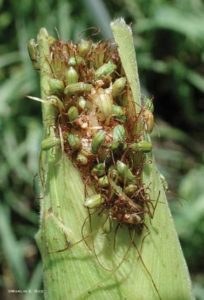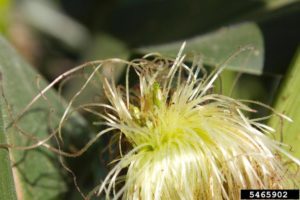By Brayden Evans
AgVenture Product Marketing Intern

Corn rootworm are strongly attracted to corn during pollination and can trim back silks to the husk. Photo by Marlin E. Rice.
Throughout the Midwest corn rootworm beetles have been a major field pest that need to be watched.
Managing corn rootworm beetles can be done several different ways. Crop rotation is one way to interfere with the corn rootworm life cycle by using a corn/soybean rotation.
AgVenture Regional Product Manager Louis Sutton, says, “Due to the high increase of rootworms we have seen over the last few years, the insects overwhelm the traits and cause issues that are not related to resistance, just an overpopulation. So, we need to monitor the fields and rotate crops to non-host crops.”
Seed treatments and insecticides can also be used to combat insect pressure.
 When it comes to best practices for corn rootworm management, remember these key tactics:
When it comes to best practices for corn rootworm management, remember these key tactics:
- Break the cycle: Rotate to soybeans or another non-host crop and avoid three or more years of continuous CRW Bt trait use.
- Manage populations: Utilize sticky traps to scout fields, determine whether a foliar insecticide is needed, and check for root injury to determine the effectiveness of your management plan.
- Protect yield potential: Plant a product with multiple modes of action against CRW, such as AgVenture brand Qrome® products and ensure your seed is protected with AgVenture’s Security Seed Protection System, powered by LumiGEN®.
 Qrome is the most optimized corn rootworm trait on the market today. The molecular stack technology featured in Qrome products enables top-performing germplasm while providing effective control of corn rootworm. In more than 7,000 plot and on-farm trials in 20211, Qrome products yielded 5.4 bu/A more than the competition.
Qrome is the most optimized corn rootworm trait on the market today. The molecular stack technology featured in Qrome products enables top-performing germplasm while providing effective control of corn rootworm. In more than 7,000 plot and on-farm trials in 20211, Qrome products yielded 5.4 bu/A more than the competition.
AgVenture product portfolio manager Darren Bakken says, “AgVenture Qrome® hybrids are the product of an innovative new technology that allows us to unlock the yield potential of our industry-leading germplasm while delivering products with superior insect control and agronomic traits. I’m excited for AgVenture growers to get the opportunity to unlock maximum profits on those acres that require dual modes of action against above and below-ground insect pests.”
Bakken is also excited for the future as he looks to the launch of the Vorceed™ Enlist® corn, combining next-generation corn rootworm protection with the power of the Enlist® weed control system. This new trait technology will provide growers flexibility to manage the toughest insects and weeds.
There are three types of corn rootworm beetles including the Northern, Western, and Southern. The Northern corn rootworm and the Western corn rootworm are considered the most common pest of corn in the Midwest.
Adult Northern and Southern corn rootworm beetles will lay eggs in field residue during the fall. The eggs will survive through the winter and begin to hatch in May and June. The larvae begin to feed on roots and cause damage to corn plants. This can cause root lodging later in the season. In July, after corn rootworm larvae have become adult beetles, they begin to feed on corn silks and pollen. This becomes a problem when it begins to interfere with corn plant pollination. When corn silks are clipped pollination is reduced causing kernels to not be filled and a reduction in yield.
If you are experiencing corn rootworm issues in your fields, talk to your AgVenture Yield Specialist to determine the best course of action for combating insect pressure and increasing bushels.
Click to find your local AgVenture Independent Seed Company
¹Qrome product performance data is based on the average of 7,494 comparisons made in the United States in 2021. Comparisons are against all competitors, segment matched, and within a +/- 3 CRM. Product performance is variable and subject to any number of environmental, disease and pest pressures. Individual results may vary and from year to year. Product label instructions must be followed at all times. No offer for sale, sale or use of these products are permitted prior to issuance of the required country, region or state registrations.
